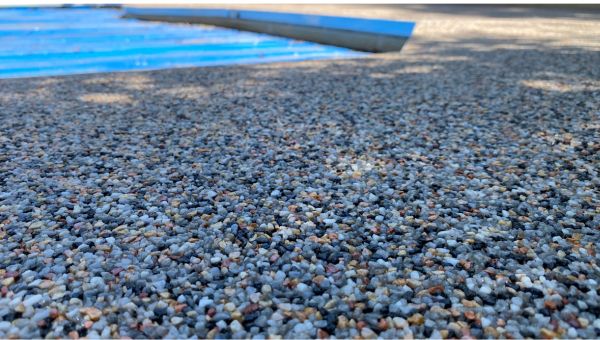A pool deck is just as important for safety as it is for aesthetic purposes. In fact it is the most used part of the pool. Although it is possible to build a pool without a deck, it is not advisable.
A pool deck acts as a distance barrier away from the water. Imagine there is no deck; Accidents like falling into the pool are almost inevitable. This can be dangerous, especially for children and non-swimmers.
A pool deck also serves important aesthetic purposes. There are many ways to make a pool deck aesthetically pleasing or functional. Some people also use the lawn, but here they do something wrong. They provide no transition between the outdoor pool deck and the lawn. This can cause problems after using the pool. This is because chlorinated water is inevitably drawn from an active pool and brought onto the deck. Then, the water goes straight to the lawn, where it causes two major problems.
First, lawns and ornamental shrubs generally do not like chlorine. When pool water gets on them, they get sick and may die over time. Second, grass is sensitive to flooding and can easily die from too much water alone. Obviously, something needs to be done to maintain the landscape around the pool.
Try A Gravel Barrier
This problem is a complicated one. Many people ignore it and miss the beauty around the pool. A simple and great way to eliminate this problem is to place a permeable gravel barrier between the edge of your pool deck and the landscaping. This will provide an area that will hold pool water without being damaged by chlorine or the amount of liquid present. Choose a nice-looking, smooth stone type. You or your kids can decide to run around the area, or just sit and enjoy the beauty.
Keep it In Place
The way to successfully use gravel in a landscape is to keep it where it belongs. This is easy to do if you use Pour-On to set the stones exactly the way you want them to be. Pour-on holds the stones in place, and since it doesn't compromise permeability, it will allow the gravel barrier to do its job of keeping pool water off your green.
You can also enhance the beauty of your pool in several ways and keep it from getting damaged. You can lay landscaping rocks around the pool. Or you can use rocks around the pool. Hence, using lawns in the manner mentioned above can further enhance the beauty of your pool and increase the value of the property.
What is the best stone to put around a pool?
Choosing the best stone for around a pool depends on various factors such as your aesthetic preferences, budget, climate, and maintenance considerations. Here are some popular options
Travertine: This natural stone is known for its durability, non-slip surface, and ability to stay cool underfoot even in hot weather. It comes in various colors and finishes, providing a sophisticated look around the pool.
Limestone: Limestone offers a classic look and is available in various shades, from light beige to dark gray. It's relatively affordable and can withstand weathering over time.
Sandstone: Sandstone is another natural stone option that comes in a range of colors and textures. It's durable and provides good traction, making it suitable for pool areas.
Granite: Granite is a tough and long-lasting option that comes in a wide range of colors. It's resistant to scratches, stains, and fading, making it a low-maintenance choice.
Bluestone: Bluestone is a popular choice for its elegant appearance and durability. It's available in different shades of blue-gray and provides a smooth surface around the pool.
Concrete Pavers: Concrete pavers offer versatility in design and are available in various shapes, sizes, and colors. They can mimic the look of natural stone while providing a more budget-friendly option.
Porcelain Tiles: Porcelain tiles are highly durable and resistant to fading, stains, and scratches. They come in a wide range of colors and patterns, allowing for creative design possibilities.
When selecting the best stone for around your pool, consider factors such as slip resistance, heat reflectivity, maintenance requirements, and how well it complements your overall landscaping design. Additionally, ensure proper installation to prevent issues such as uneven settling or water pooling.
River Rock Around Pool Deck
Using river rock around a pool deck can create a natural and visually appealing landscape. River rocks offer several benefits, but there are also considerations to keep in mind:
Pros:
Natural Aesthetic: River rocks provide a natural and organic look, enhancing the beauty of your pool area.
Texture and Variation: River rocks come in various sizes, shapes, and colors, offering texture and visual interest to the landscape.
Drainage: River rocks allow for good drainage, which can help prevent water from pooling around the pool area.
Low Maintenance: Once installed, river rocks generally require minimal maintenance, such as occasional rinsing to remove debris.
Cons:
Heat Retention: River rocks can absorb and retain heat, making them hot to walk on during sunny days. This can be uncomfortable for bare feet.
Slippery Surface: Depending on the size and smoothness of the river rocks, they can be slippery when wet. This may pose a slip hazard, especially around the pool area.
Debris Accumulation: Small debris such as leaves and twigs may accumulate among the river rocks, requiring periodic cleaning.
Weed Growth: Without proper landscape fabric or weed barrier installation, weeds and grass may grow among the river rocks over time, requiring maintenance.
Considerations:
Size and Placement: Choose river rocks of appropriate size to ensure comfortable walking around the pool deck. Larger rocks may be uncomfortable to walk on, while smaller ones can be less stable.
Edging and Containment: Proper edging or containment is essential to prevent river rocks from spilling into the pool or surrounding areas.
Heat Mitigation: To mitigate heat retention, consider incorporating other materials such as concrete or decking for areas where people will frequently walk or lounge.
Safety Measures: If using river rocks in areas prone to slipping, consider adding non-slip coatings or mats for safety.
Overall, river rocks can be a beautiful and natural choice for landscaping around a pool deck, but it's essential to weigh the pros and cons and take necessary precautions to ensure safety and maintenance ease.




